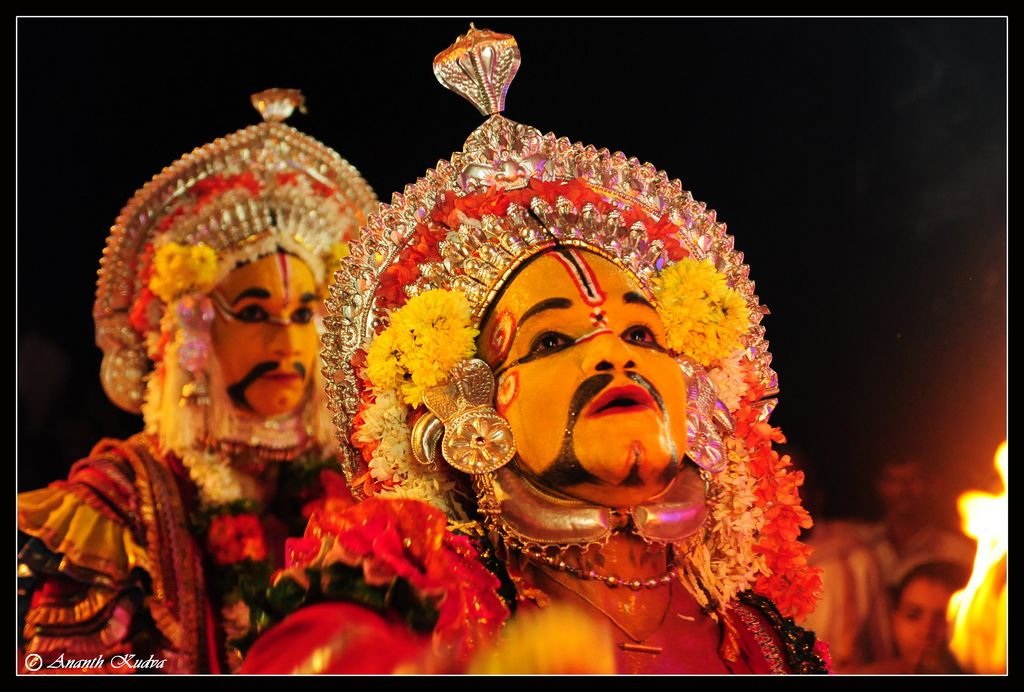Hey friends! Here I share the fiery folk art of coastal Karnataka whose name is Bhoota Kola-Bhootha Aradhane. Bhoota Kola is the ancient Tulu tradition that villagers organize to ensure peace in the village.
Bhoota means spirit and kola means play in tulu. In Dakshina Kannada in Karnataka and several areas of Kerala, tulu-speaking people perform a ritual that is essentially a form of spirit worship.
The villagers and their ancestors believe that certain Gods protect their lands and take care of their everyday affairs even today. It is believed that the anger of these spirits could bring bad luck.

A few spirits worshiped are Panjurli, accompanied by his sister Varthe, Kalluri, Kalkuda, Kordhabbu, Guliga, Jarandaya, Bobbarya and so on. There are stories describing their heroism and how they came to be worshiped. According to people, these spirits are neither good nor bad. Kola is also called ‘nema’ which is a ritual that takes place from night to daybreak.
On this ritual, a movie is recently released named Kantra. If you see this movie you can have more information about it. In this movie, you can see the performer how beautifully have done this fierce folk art with an aggressive look. Now a Controversy is also going on that this ritual belongs to the Hindu part. This movie now becoming the second highest-grossing Kannada film of all time beating Yash-starrer ‘KGF’.
What is Bhoota-Kola dance?

One of the most well-known forms of art in coastal Karnataka is called Bhuta Kola, a highly stylized ritual dance of the possessed that uses make-up, costumes, speech, dance, and music to describe a mystical world of supernatural beings. Bhootada Kola is performed by a trained person who is said to have temporarily become a god.
The performer displays an aggressive attitude, dances fiercely, and performs many rituals. This artist is feared and respected in the community and is said to give answers to human problems on behalf of the god. Drums and music give company to the dancing and pooja rituals. By praying together during Bhootada Kola, the community seeks God’s blessing, prosperity and relief from various problems facing the community.
Bhoota-Kola Face Painting:-

Daiva’s face paint creates vivid visual appeal. Arrange the vivid colors and curves of the body to create a mysterious look. Face painting contains a lot of intricate detailing. The performer’s eyes are painted black. Apart from the beauty that it gives to the entire face; Black also symbolizes mystery and fear. It also helps to hide eye features as it is easy to recognise the dancers through their eyes. So when these Daiva impersonators look at themselves, they are unable to recognise themselves.
With the addition of the makeup characteristics to their overall get-up, they would have a completely different face. Red or orange paint is applied to the remaining part of the face. Red is a stimulating color that’s related to energy and it instantly grabs the viewers’ attention. The significance of the colors utilized in the Ritual is fascinating. The Daiva impersonators are this manner slowly ready for self-hypnosis to impose the spirits on them.

Kola is also an occasion for villagers to make offerings to their gods, as it usually takes families about a month to prepare for the Kola ceremony. The Bhoota-Kola ceremony is usually held from December to May. During this month, the villagers help the main family and worship their village God together once or twice a year or on special occasions.
Our country is full of different cultures, one of them this is very interesting if you go there and will experience yourself then you feel different like that environment feels you very energetic and full of devotion. You all must go there and what experience you have, plz share in the comment box. Hope you enjoy this article and have much more information about it.